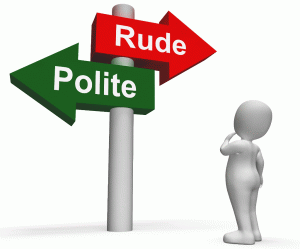A combination of the words “network,” and “etiquette,” the term “netiquette” is basically what has been called good manners, applied to technology.
 But while most of us can state a few of the universals (such as using all capital letters can be interpreted as shouting – don’t do it), which indeed is universally the case, there are distinct differences between email in business, emailing friends and family, and email in the school situation, to be considered.
But while most of us can state a few of the universals (such as using all capital letters can be interpreted as shouting – don’t do it), which indeed is universally the case, there are distinct differences between email in business, emailing friends and family, and email in the school situation, to be considered.
For example, some authorities recommend using emoticons (smiley faces, frowning faces, and so on) as good shortcuts – in the informal situation. Most agree they should not be used in a business email. So let’s take look at six serious tips for effective business email netiquette.
1. Many companies and organizations provide a sort of style manual with netiquette guidelines to clarify for their employees what is acceptable, and what is not, in their emails. In addition to matters of safety, basic courtesy, and privacy, these guidelines define how that company, or that organization wants to be represented to its various email audiences.
2. Do not send to a list, or “reply all” without first knowing who is on that list, and removing anyone who does not need to receive a particular email. Time after time, in every discussion of effective email, the winner of the “ineffective award” is the practice of sending everything to everyone. A major time-waster within the organization, a source of irritation, and an invitation to the potential reader to delete without reading. This result is compounded when the writer becomes known for sending, or replying to all – whether they need the information, or not.
3. Be careful of the tone you use. While you obviously are not about to correct a client, or a superior in your organization, avoid the temptation to “reply all” – especially when a co-worker makes a mistake – maybe a spelling error, using the wrong word, giving an overlong answer, or asking a “stupid question.” It’s important to maintain a teamwork mentality. Minor errors internally can often be ignored. If the error is more serious, discuss the issue privately, or with an email only to the individual involved.
4. Don’t impose on your reader’s time. Keep your messages focused, and as short as possible. Many people use mobile devices and phones for email, in most cases making a long message difficult to read. Focus will help to get your email read, make your point, or provide information as quickly, and as briefly as possible.
Keep in mind that while the common abbreviations, e.g., LOL (laugh out loud), BTW (by the way), or BRB (be right back) are used to write faster, and shorten the message in an informal email, they are neither professional nor appropriate in the business situation.
5. Avoid giving offense. Keep in mind, and be sensitive to the cultural and language differences among your readers. Use good taste certainly in the business situation, and also when writing to your other email readers. Avoid profanity, slang that could be misunderstood, and rude, hurtful, or judgmental comments. Things that may seem funny when spoken often come across the wrong way in email.
6. Be professional. Use correct grammar, spelling, and punctuation. Spellchecker can be a good starting point, and your spelling, grammar, thesaurus, and dictionary tools are just a fingertip away. Be sure to do a final personal “eyeball check” before hitting “send.”
Additionally, use a professional email address for business correspondence. Avoid an address that could be construed as too informal, suggestive, or carry a possible negative connotation.
Please comment below, and share your favorite email pets and peeves!
Gail Tycer offers business writing workshops and presentations, executive coaching, consulting, and writing services. To discuss how we can help, call Gail at 503/292-9681, Toll-free at 888-634-4875 or email gail@gailtycer.com

